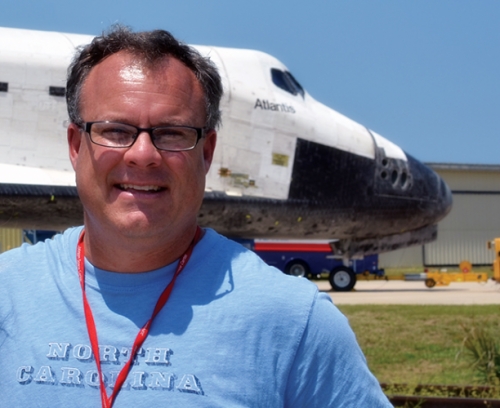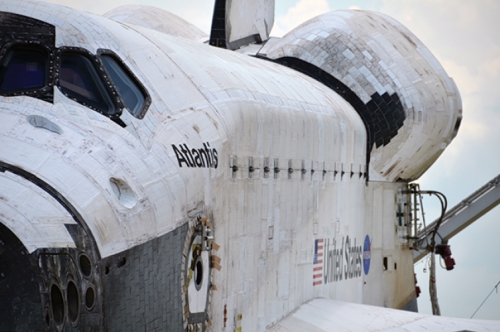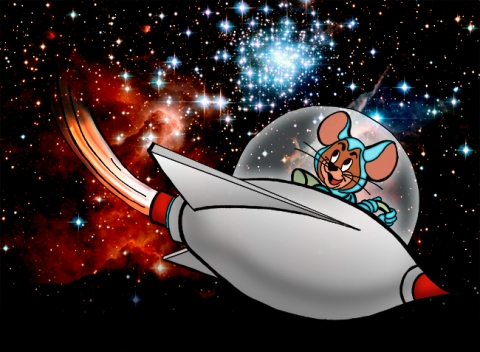Before Ted Bateman became a space geek, he was a science nerd and proud of it. As a ten-year-old he delighted in dissecting the frogs and sheep lungs that his mom the biology teacher brought home from school. He once got a cat—already dead—from the Humane Society so he could bleach the bones and piece together the skeleton for an end-of-year project. And when he was twelve he designed his first mouse experiment at a science fair.
“I had three mice,” he remembers. “I fed one normal lab chow, one soybeans, and one Frosted Flakes.” Then for two weeks he ran them through a maze that he and his grandfather had built. The soybean mouse was always the clear winner. “It wasn’t very scientific,” Bateman admits. “But it was really cool.”
Thirty years later, as a biomedical engineer, Bateman is still running experiments with mice. Except now he works with NASA, and his experiments have much more relevance to human health. He and colleagues around the country want to know what near-zero gravity does to bone density and whether new drugs can promote bone growth. Their research isn’t just for the next generation of astronauts, but for the rest of us, too.
“Space flight is really a model for accelerated aging,” Bateman says. “Many things astronauts experience in microgravity happen to us when we get older—muscle atrophy, bone loss, cardiovascular deconditioning, immune dysfunction.”
And it turns out space flight is also a good model for radiation exposure. When cancer patients undergo radiation treatment, they lose bone mass. Bateman is trying to understand how that happens and what can be done about it.
In 1990 Bateman met his future. He was one of six physics majors at a small liberal arts college, but one of two from Fort Collins, Colorado. He befriended this fellow Coloradan, whose dad happened to work for NASA’s Space Life Sciences Training Program, a six-week learn-a-thon for aspiring engineers. The father encouraged Bateman to apply; the next year, Bateman was accepted.
He listened to lectures from prominent scientists, learned how NASA operated, and saw how researchers designed animal experiments using sea urchins and rats. Bateman was sold. He enrolled in graduate school, where he helped design structures that astronauts could live in. Later he earned a doctorate in bioengineering and collaborated with BioServe Space Technologies at the University of Colorado, which conducted microgravity research and designed space-flight hardware.
“From then on my life has been kind of outlined by space shuttle flights,” Bateman says. In 1996 he flew rats on STS-77 (that’s the seventy-seventh mission of the space transportation system, a.k.a. the space shuttle.) Bateman helped design an experiment with NASA and the drug company Chiron to see if a hormone called insulin-like growth factor 1 increased bone growth. It did, but was never approved as a drug to grow bone tissue because it was too nonspecific. “Anything anabolic—anything that grows bone tissue—can potentially promote the growth of other things in the body,” Bateman says. “Cancer cells, for instance.”
That experiment, though, did yield fruit for Bateman. He wondered why NASA used rats for experiments instead of mice; most scientists preferred mice for their genetic variability. “Essentially NASA was wed to rats because rats don’t smell as bad as mice,” Bateman says. But he and colleagues proved that astronauts would have to put their noses right up against the glass mouse enclosures just to get a whiff of the furry little space-goers. And there was no reason for astronauts to do that; they barely even needed to check on the mice.
NASA relented. In December 2001, mice went on their first space odyssey. Bateman was in charge of every aspect of an experiment that took months to piece together with NASA, the biotechnology company Amgen, and other researchers. Its goal was to see if a protein called osteoprotegerin could keep mice from losing bone mass in space.
The mice were in orbit twelve days. A day before liftoff, Bateman’s team injected some of them with the drug and some with a placebo. The mice were put on board twenty-two hours before the launch, and there they stayed. The astronauts hardly paid them any mind, except to visually check to make sure they were okay. They were. In microgravity, the mice could sprint up the wall, across the ceiling, and down the other side of their glass enclosure over and over. They nibbled on a big chunk of food affixed to the wall of their enclosure. To drink, they sucked on a nozzle attached to a spring-loaded water bag. The mice floated much like astronauts, using their forelimbs to maneuver around their habitats.
When the rodents returned, Bateman’s team found that osteoprotegerin worked exceedingly well. Nine years later Amgen gained FDA approval for a drug astronauts have since used to prevent bone loss.
For the earthbound among us, though, preventing bone loss isn’t always enough. Osteoporosis, for instance, often isn’t diagnosed until bone density has already been depleted. One solution could be a drug that actually grows bone tissue. That fact was on Bateman’s mind when STS-118 rolled around in 2007. That mission featured mice treated with a drug aimed at increasing muscle mass. It worked, and Bateman’s team found that the drug also promoted bone growth. It’s now in clinical trials.
Bateman, by then a professor at Clemson, was making another connection between space travel and life on Earth. Astronauts are exposed to radiation, which can deplete bone tissue. “But that dose of radiation,” he says, “is much lower than what cancer patients get during radiation therapy.” Bateman wanted to find out what happened to these patients and, more specifically, what happened to their bone cells.
Bone tissue is composed of two major kinds of cells: osteoclasts, which limit bone growth, and osteoblasts, which promote bone growth. Together, they maintain proper bone density.
In 2007 Bateman teamed up with researchers at UC Irvine to measure how much bone mass cervical cancer patients lost after six weeks of radiation and what exactly the radiation did to osteoclasts and osteoblasts. The conventional theory was that radiation damages osteoblasts, resulting in a gradual decline in bone mass over time. But that’s not what Bateman and his collaborators saw. They found that radiation turns on osteoclasts, which spurs the initial bone loss. Then, as radiation treatment continues, osteoblasts are suppressed. “We found that bone loss is incredibly rapid and just massive,” he says.
Bateman thinks existing therapies that diminish osteoclast activity could help patients. As for drugs that promote bone growth, there’s only one on the market. “It’s very expensive and you have to get a daily injection,” Bateman says. We should have better options, he says, and we should know what happens to patients with all kinds of cancers who undergo radiation treatment.
For that, Bateman, who came to Carolina in 2010, has teamed up with radiation oncologist Larry Marks to start clinical trials for lung cancer and prostate cancer patients. They’ve designed a study and have collaborators lined up, but they need funding. Bateman was working on that when NASA and Amgen approached him about participating in the final space shuttle flight.
“I was really too busy moving the lab to UNC to be involved with the mission,” he says. “But my wife reminded me that I’d seriously regret not doing this. And she was right.” So Bateman spent several months helping BioServe gather scientists from five universities and coordinate their work with NASA and Amgen to test a bone-promoting antibody on thirty mice.
In July 2011, BioServe and Bateman’s team traveled to Cape Canaveral to participate in the launch festivities. They did what they always had done—prepped the mice, secured them in the shuttle’s mid-deck locker, and made sure their enclosures were functioning properly. (Air must flow from the ceiling to the floor to make sure the mouse waste floats downward.) Thirteen days later the mice, men, and woman of Atlantis returned home safely.
The other labs have yet to report their findings, but Bateman’s team found that the placebo mice lost bone mass as expected, and the drug-treated mice gained bone. The next step is to conduct clinical trials to see if the antibody can help prevent osteoporosis and bone fractures in humans. Or if it can help cancer patients maintain bone density.
As for Bateman’s career as NASA’s mice man, it might be over. There won’t be any more space shuttle flights, and NASA won’t be flying mice anytime soon.
Private rocket builders, though, could pick up the slack. One company will be ready to fly to the International Space Station next year. BioServe, Bateman’s old stomping grounds, is slated to help design experiments with yeasts and bacteria on subsequent flights. Bateman thinks that animal experiments won’t be far behind. Will he be the man in charge, wrangling researchers, rocket entrepreneurs, and drug companies?
“Organizing these flights is sort of like having a kid,” Bateman says. “You forget how much work it is. You need enough time to pass. But let’s just say that if I’m asked I’ll have a tough time saying no.”
Ted Bateman is an associate professor in UNC and NC State’s Joint Department of Biomedical Engineering. He received funding from the National Space Biomedical Research Institute, NASA’s Human Research Program, the National Institutes of Health, and Amgen, Inc.






